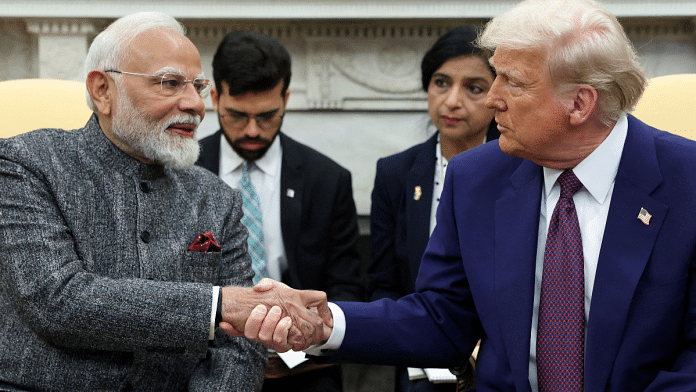Thank you dear subscribers, we are overwhelmed with your response.
Your Turn is a unique section from ThePrint featuring points of view from its subscribers. If you are a subscriber, have a point of view, please send it to us. If not, do subscribe here: https://theprint.in/subscribe/
By Ranjan Solomon
Tariffs, Russian oil purchases, and renewed tensions regarding Pakistan have caused a downturn in the U.S.–Indian relationship, replete with public insults and recriminations. As Washington and New Delhi evaluate the state of things, it is prudent to remember why India has emerged over the last generation as one of the United States’ most important global partners. It is also time to consider how to fortify a relationship based not merely on opportunistic alignment, but on principles that can withstand disagreements.
The United States and India are not natural allies in the conventional sense. Their histories, geographies, and national interests are deeply distinct. India seeks strategic autonomy—avoiding permanent alignment—while the U.S. expects partners to fall in line with its global security priorities. This clash explains recurring tensions: Washington presses New Delhi to isolate Russia, reduce tariffs, or support U.S. positions on China, while India resists being drawn into what it views as external quarrels.
India’s continued purchase of discounted Russian oil, even during the Ukraine war, underscores its pragmatism: energy security and inflation control outweigh Western sanctions. U.S. policymakers interpret this as defiance. India’s hesitations to condemn Russia outright, or to join Western military coalitions, have invited criticism in Washington. On trade, both nations accuse the other of protectionism, with India resisting agricultural and digital market openings, and the U.S. imposing visa restrictions and tariff pressures.
Despite these frictions, both sides recognize that disengagement is not an option. For India, the U.S. is its largest trading partner and a key source of technology, investment, and higher education [4]. For the U.S., India is indispensable in balancing China’s rise in Asia, contributing to supply-chain diversification, and offering democratic legitimacy to coalitions such as the Quad. The Indian diaspora in the U.S. further deepens cultural and economic ties.
The shared democratic ethos, however strained in practice, continues to provide rhetorical glue. Both countries claim commitment to pluralism, rule of law, and openness, even though each faces domestic democratic backsliding. These values remain a basis for dialogue and mutual accountability.
A principled relationship requires more than transactional bargains and short-term alignments. It must rest on a clear recognition that the U.S. and India are not merely partners of convenience, but actors responsible to a global community. To that end, both nations must resist the temptation of reducing their ties to a ledger of arms purchases, oil supplies, or tariff concessions.
First, there must be respect for strategic autonomy, particularly from the Indian side, and humility from the U.S. in accepting it. India will never be a subordinate ally within Washington’s security architecture; its political philosophy has long rested on non-alignment, multipolarity, and balance of power. That orientation is not obstructionism but a conscious attempt to preserve space for dialogue, regional cooperation, and independent judgment. A principled partnership requires the U.S. to engage with this worldview rather than treat it as inconvenient deviation.
Second, ideology must matter. Both India and the U.S. claim to be democracies, rooted—at least in aspiration—in pluralism, constitutionalism, and the dignity of individual rights. These values should not be invoked selectively but ought to form the normative ground on which policy is debated. A principled relationship requires mutual accountability: Washington cannot gloss over democratic backsliding in India, nor can New Delhi ignore American double standards in foreign interventions. Instead of silence or opportunism, both countries should hold one another to higher standards, precisely because they call themselves democracies.
Third, the framework for engagement should be dialogical and just, rather than coercive or arbitrary. International relations have too often been governed by the dictum that “might makes right.” Such a philosophy breeds resentment, instability, and mistrust. What India and the U.S. could pioneer together is a model of principled dialogue—acknowledging disputes, debating them openly, and working towards outcomes that are equitable. The emphasis must be on justice between nations, not domination by the more powerful.
Finally, both nations must see their partnership as serving not only narrow national interests but also the wider global good. That means collaborating on climate change, health, food security, and technology in ways that prioritize humanity over hegemony. A truly principled U.S.–India relationship would be one that strengthens multilateralism, fosters fairer trade systems, and defends the rights of weaker states rather than treating them as pawns.
In sum, if India and the United States want a partnership that endures beyond the fluctuations of tariffs or oil purchases, they must root their relationship in philosophy as much as strategy, in dialogue as much as deals, and in justice as much as power. Anything less will reduce their engagement to opportunism; anything more could make it a model for 21st-century international relations.
References (placeholders – to be updated with specific works)
[1] C. Raja Mohan, Crossroads Asia: India’s Foreign Policy Choices (2022).
[2] Tanvi Madan, Brookings Institution, “India’s Russia Balancing Act” (2023).
[3] USTR Report on Trade Barriers, 2024.
[4] Ministry of Commerce, Government of India, Trade Data (2024).
[5] Pew Research Center, “Indian Diaspora in America” (2023).
[6] Freedom House, Freedom in the World Report (2024).
[7] Non-Aligned Movement archives, principles of strategic autonomy.
[8] Amartya Sen, The Argumentative Indian (2005).
[9] Hedley Bull, The Anarchical Society (1977).
[10] United Nations, Our Common Agenda (2022).
These pieces are being published as they have been received – they have not been edited/fact-checked by ThePrint.


